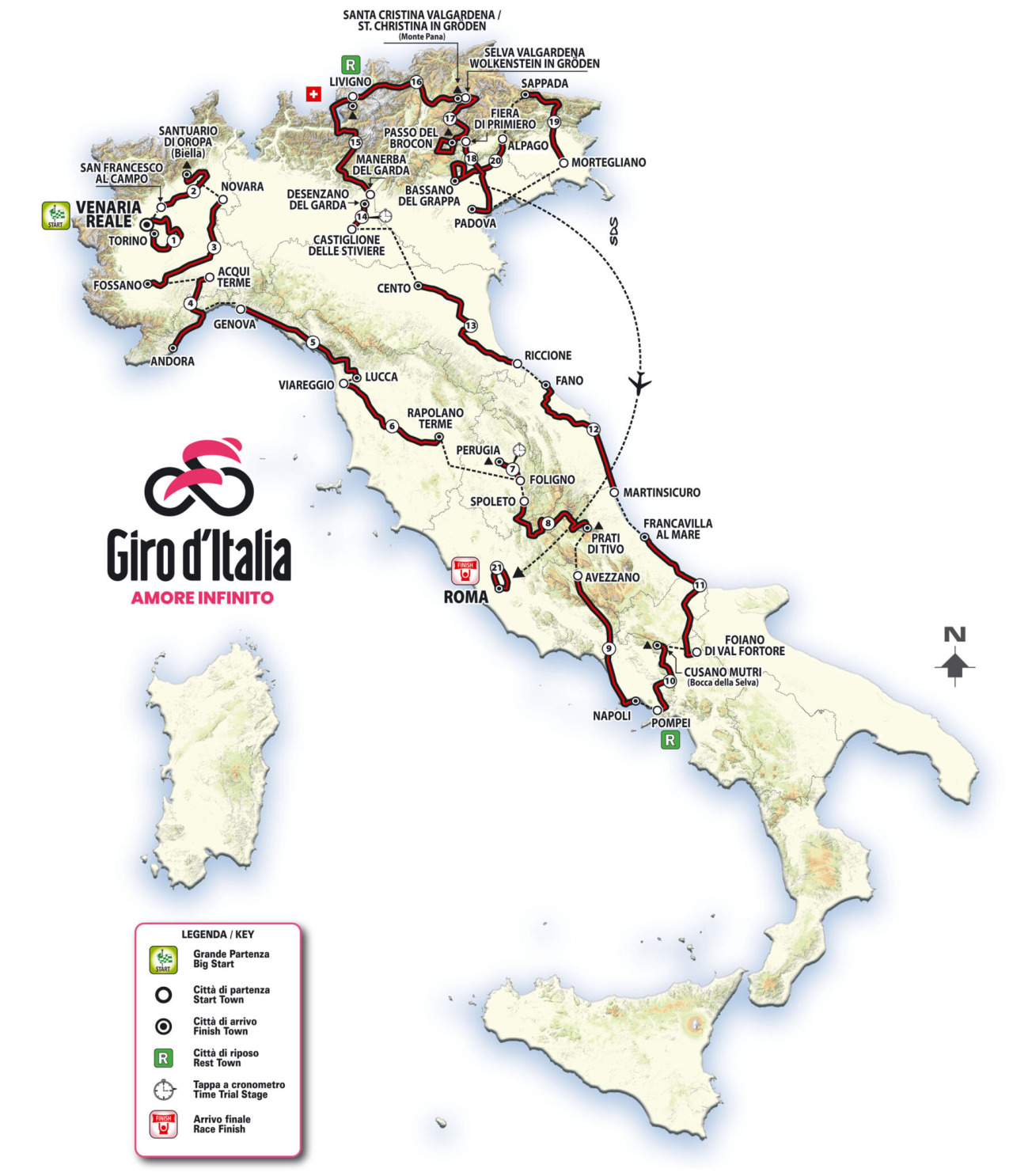
Here’s the Giro d’Italia guide. You’ll find all the stage profiles together on one page, along with concise preview of each day…
…as well as explainers on the rules for the mountains and points competitions; TV guide and more. But this part is a work-in-progress pending publication of the race rulebook for 2024.
Route summary
In one word: gentler. It’s shorter as the average stage length is 173km, down 20km from last year. It’s flatter, with about 44,000m of vertical gain which means 8,000m (15%) less than 2023, the least amount since 2010. If there are six summit finishes some of these are “big ring” types of climbs.
Two time trials totalling 70km make the overall win tricky for pure climbers and there could be up to nine bunch sprints.

Stage 1 – Saturday 4 May – 1850m V+

An gentler Giro but no soft start. This is a short, crunchy stage and possibly the chance for Tadej Pogačar to take the maglia rosa… and keep it to Rome. A feat not achieved since Gianni Bugno in 1990 but would it be wise to try? The stage win, yes but defending the lead in the coming days is another matter. He’ll find plenty of rivals at least for the win in Torino.
Stage 2 – Sunday 5 May – 2300m V+

A scenic ride via the “Zegna Oasis”, a park created by the eponymous fashion designer. The Oropa summit finish is no walk in the park, listed as 11.8km at 6.2%, this includes the easy roads out of Biella that lead to a fierce 7km section that almost never goes below 8% as it winds up through the woodland with steep hairpins, this is a big day for the GC contenders.
Stage 3 – Monday 6 May – 750m V+
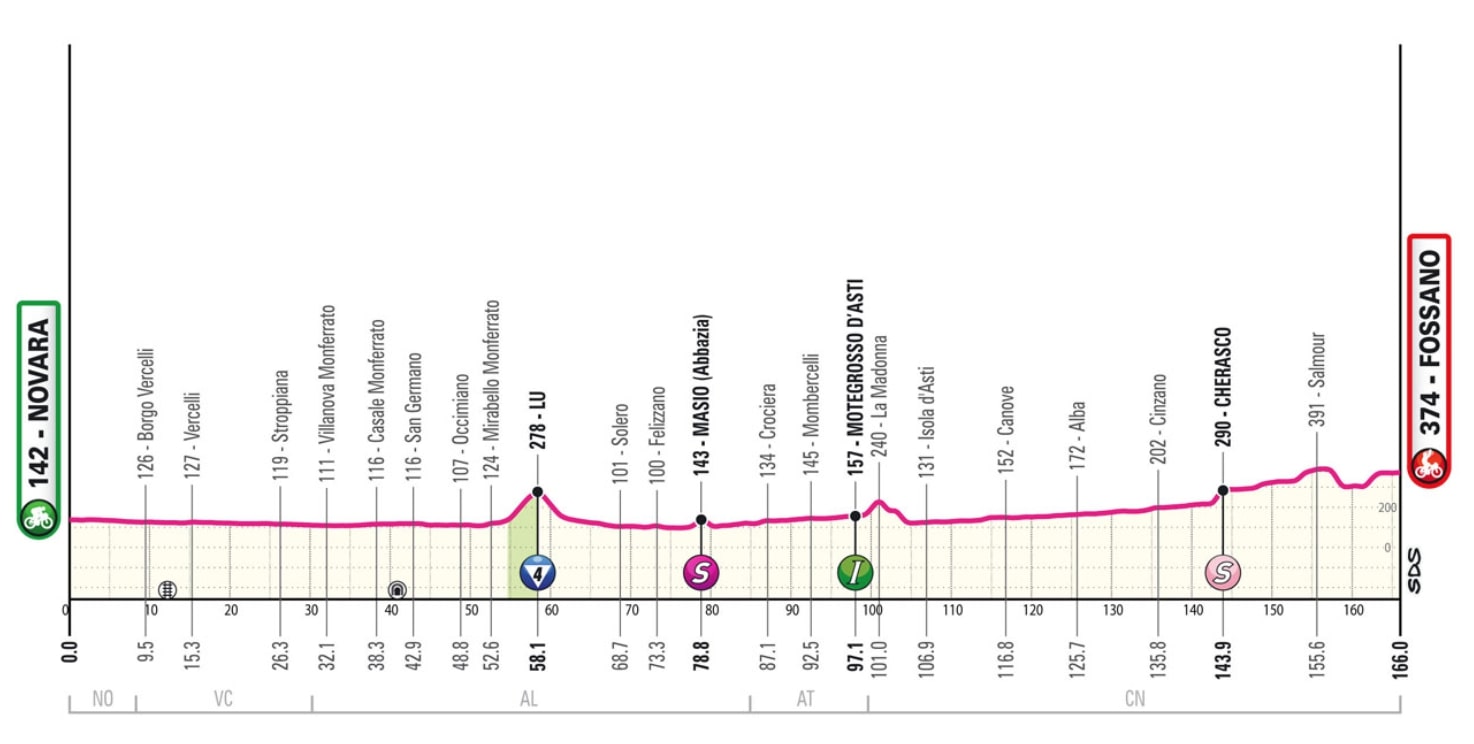
Monday and a sprint stage as the race crosses the plains. There’s more food and wine than sport as it passes risotto rice fields and plenty of vineyards before the climb to Fossano which could sour things for the sprinters.
Stage 4 – Tuesday 7 May – 1700m V+

A start in Acqui Terme, famous for its “boiling spring” that has gushed out steaming water since Roman days but the race won’t reach boiling point until late as it crosses over the Ligurian hills to the Mediterranean and then takes up the Milan-Sanremo. Like the previous day a short climb, this time the Capo Mele, the easiest of the capi triology, is there to disrupt sprint trains before the finish.
Stage 5 – Wednesday 8 May – 1700m V+

After the previous day’s Milan-Sanremo déjà vu, more familiar roads with the Passo del Bracco, this time taken in the opposite direction to the 2023 Giro and then a finish in Lucca in one of the regional heartlands of Italian cycling and here the Montemagno climb is gentle. This is the third sprint stage in a row.
Stage 6 – Thursday 9 May – 1900m V+

The sterrato or strade bianche stage with three sections totalling 11.6km to the south of Siena. It’s a more gentle day than the Giro’s 2021 stage to Montalcino but there’s still 1,900m of vertical gain here, and packed in the second half. The gravel gets the headlines but there are plenty of twisty tarmac roads with steep ramps to make the going hard too.
Stage 7 – Friday 10 May – 400m V+

The first time trial stage and the profile says it all, flat for 34km before the climb to Perugia including some steep parts. Two time trial stages in this race are an invitation to hulking homeland hero Filippo Ganna.
Stage 8 – Saturday 11 May – 3750m V+

A hard day, a real mountain stage. An unmarked but very real climb out of Spoleto will help the breakaway go clear. Prato di Tivo’s been a regular in Tirreno-Adriatico, eg 2021, and hosts the second summit finish of the Giro. It’s a long climb on a wide road, a ski station summit finish but with a wild feel as it’s remote. Once again near the Gran Sasso, RCS will be praying there’s no headwind so as to avoid last year’s anticlimactic outcome at nearby Campo Imperatore.
Stage 9 – Sunday 12 May – 1300m V+
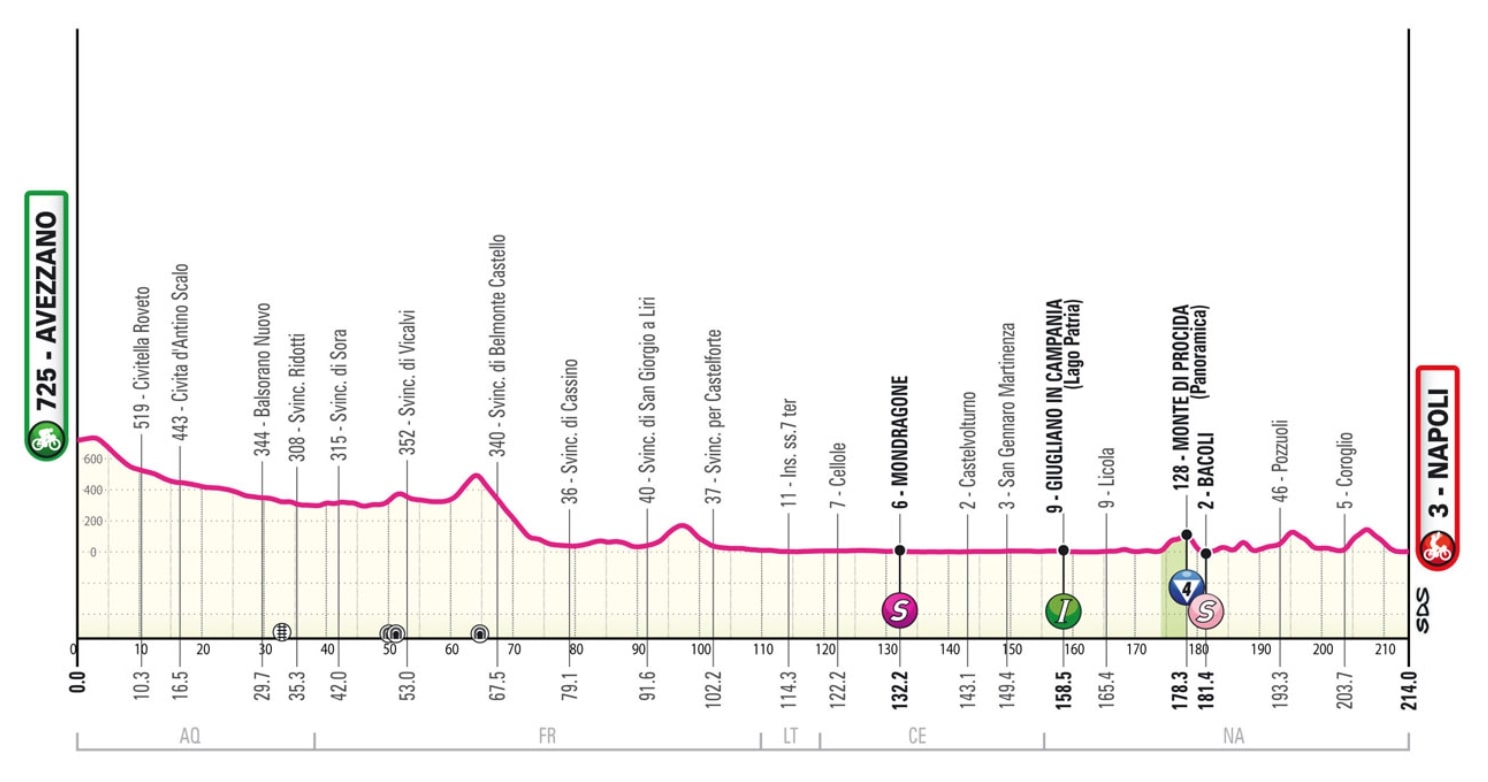
The Giro is back to Napoli for the third year in a row and this time a possible sprint finish but with some tricky roads in the finale, this is no dragster finish. First via the volcanic campi flegrei – said to be more risky than Vesuvius for a disastrous eruption – then into the urban streets where the peloton has its own risk. At 206km it’s the longest stage of the opening week.
Stage 10 – Tuesday 14 May – 2850m V+

A start in Pompeii and the Giro reaches its southernmost point for the three weeks before heading north into the Matese hills and a summit finish on the Bocca della Selva, a long climb but rarely steep, a big ring kind of climb or what is called pedalabile, “pedalable” in Italian, and a probable breakaway day but only 141km.
Stage 11 – Wednesday 15 May – 1850m V+

A sprint stage on the coast.
Stage 12 – Thursday 16 May – 2100m V+
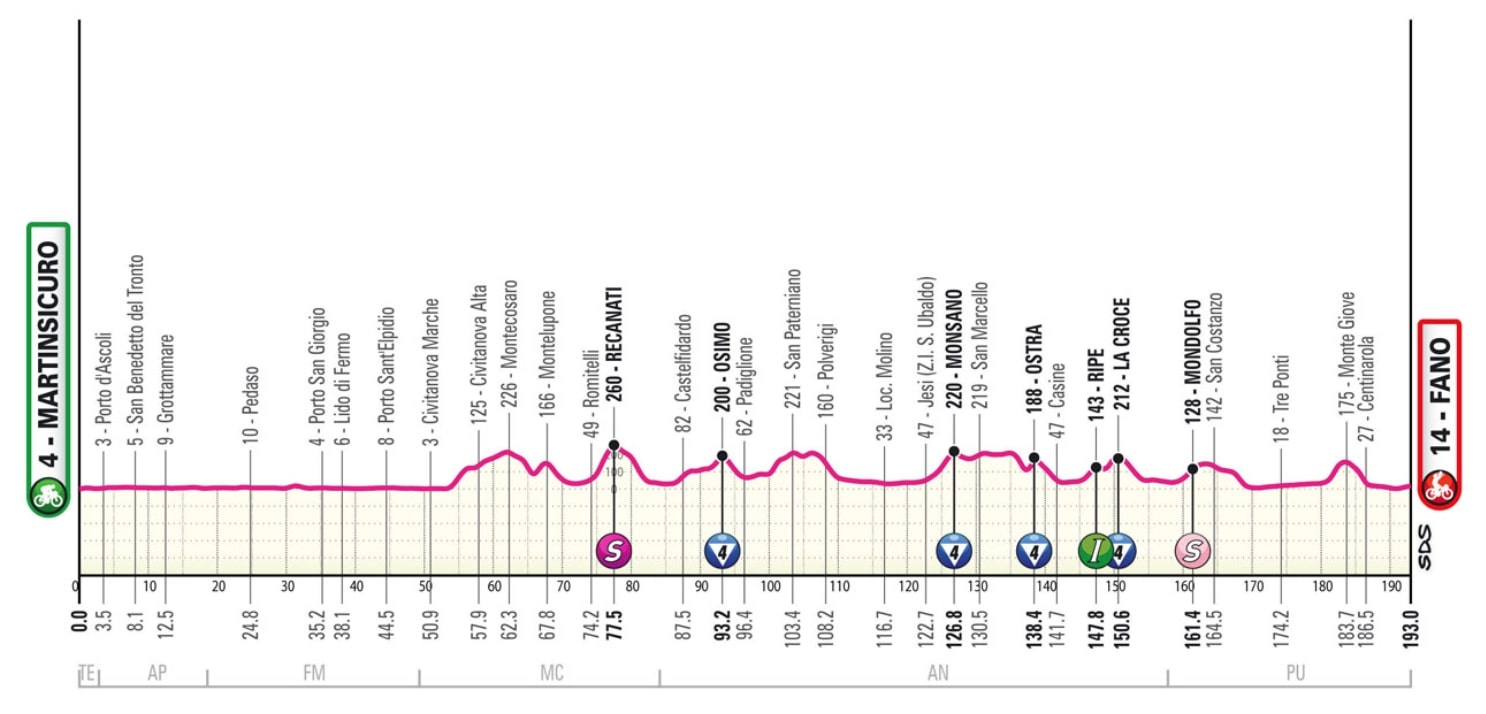
A fun stage with some of the “wall” climbs from Tirreno-Adriatico, but none of the wildest ramps. There are six categorised climbs and more unmarked ones.
Stage 13 – Friday 17 May – 150m V+
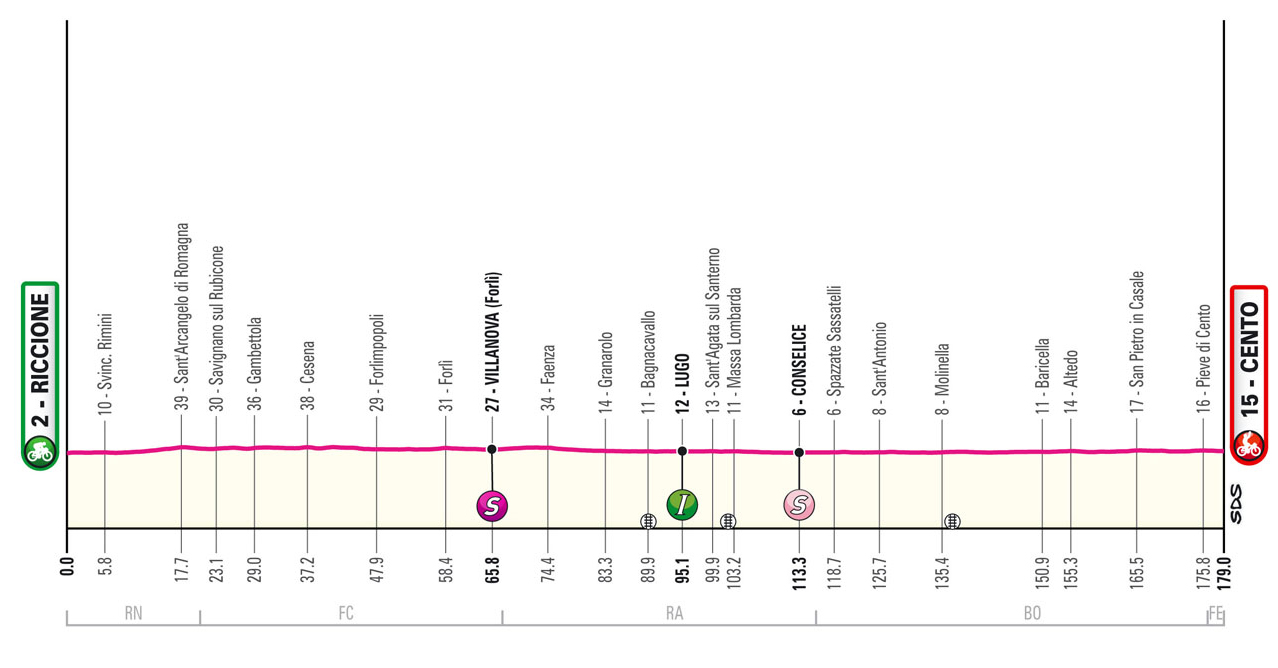
A sprint stage.
Stage 14 – Saturday 18 May – 100m V+

The second time trial stage and flat. It’s on rural, twisting roads where a good line saves seconds.
Stage 15 – Sunday 19 May – 5250m V+
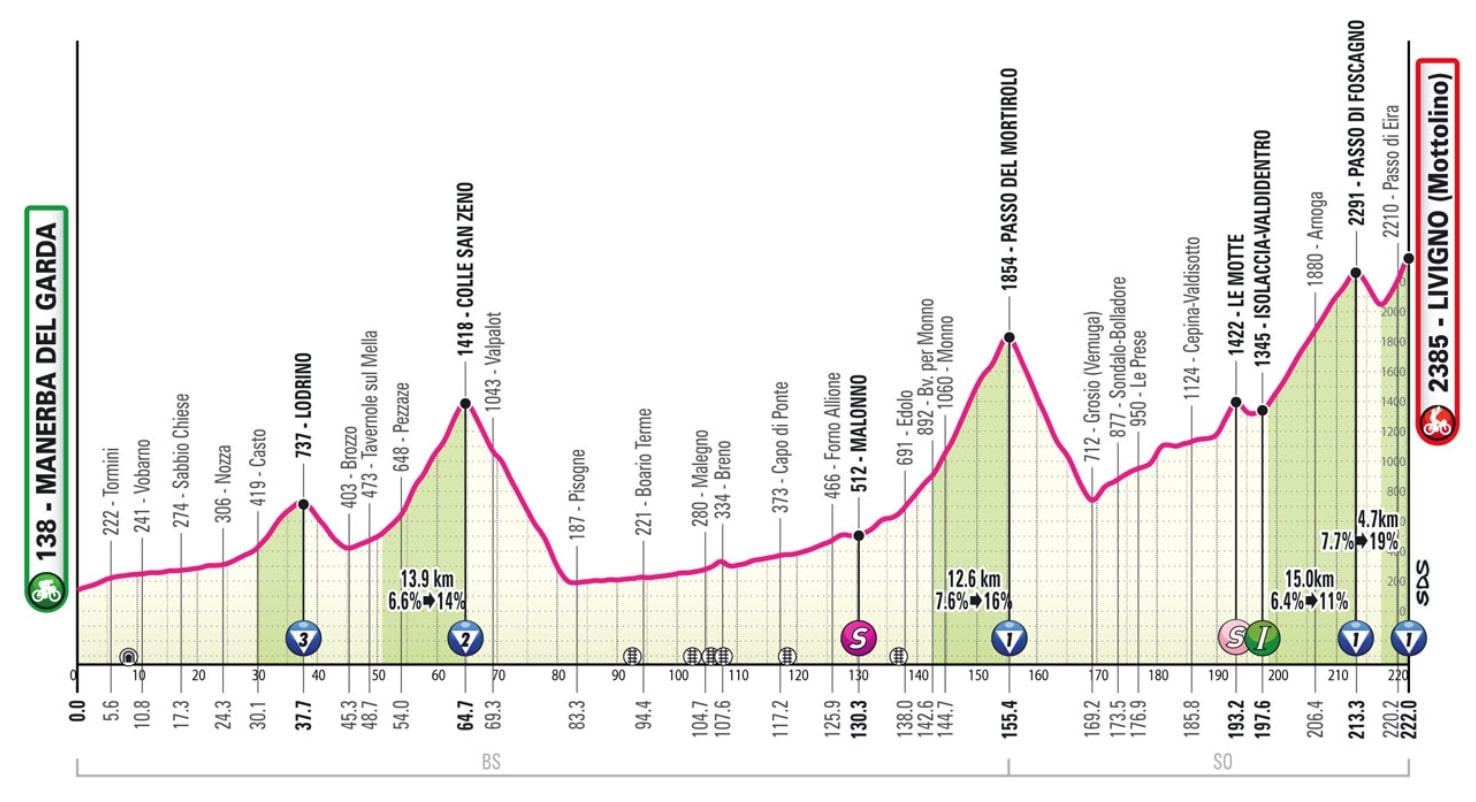
The tappone. In a Giro of shortened stages this is the longest stage of the race. A 220km marathon and over 5,000m of vertical gain. The Mortirolo is mid-stage and if it’s climbed by the easy side that means they descend the trickiest slopes. Mottolino, not so much a ski resort as a ski piste, for the 2026 Winter Olympics in Livigno. It’s via the main road to the Passo Eira, then a turn onto a small service road with sections from 9-17%. As a one way road up, the rest day after is planned to allow more time to get the race infrastructure down the mountain.
Stage 16 – Tuesday 21 May – 4350m V+

Two mountain passes but then the Umbrail from Bormio and the Cima Coppi high point, it’s almost nine tenths of the Passo Stelvio but the Plan B after avalanches rule out the Stelvio descent. It’s a big day for the mountains competition as it’s in the stage and the springboard for a breakaway. Then a long procession into South Tyrol and Italy’s German-speaking corner ending in a summit finish above Ortisei with gentler gradients to start before 3km at over 10% on the Panastraße.
Stage 17 – Wednesday 22 May – 4100m V+
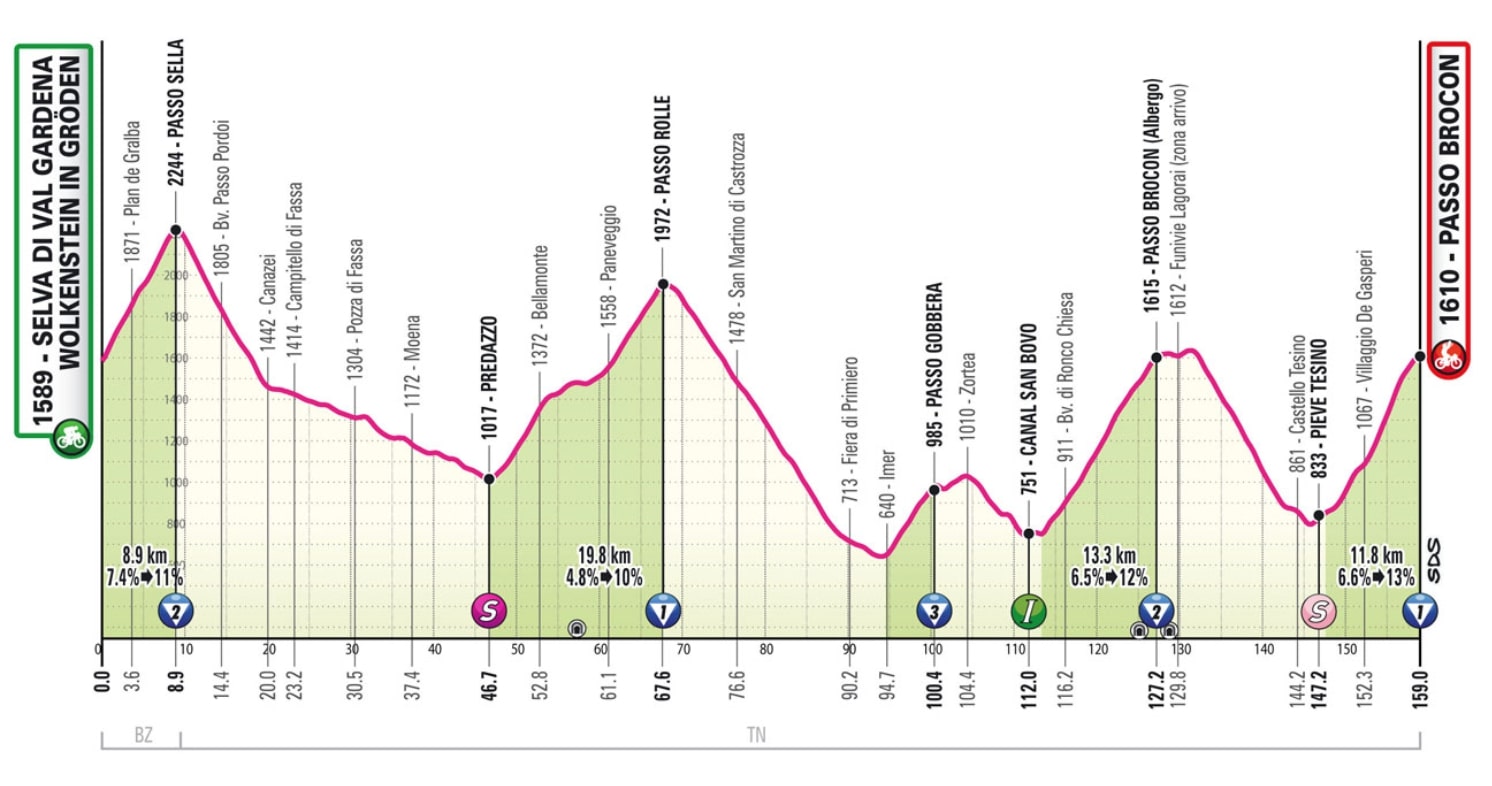
If stage 15 was the tappone, this is another claim to royalty. The Dolomites and 4,100m of climbing compressed into 159km with the famous Selva and Rolle passes before the “new” Passo Brocon, climbed here twice: once from the north then a descent to the south before climbing back up another version of the southern flank. The stats on the profile say the first time is easier but the second time up is more uneven and has some steeper parts. Neither side is savage but combined they’ll be selective.
Stage 18 – Thursday 23 May – 550m V+
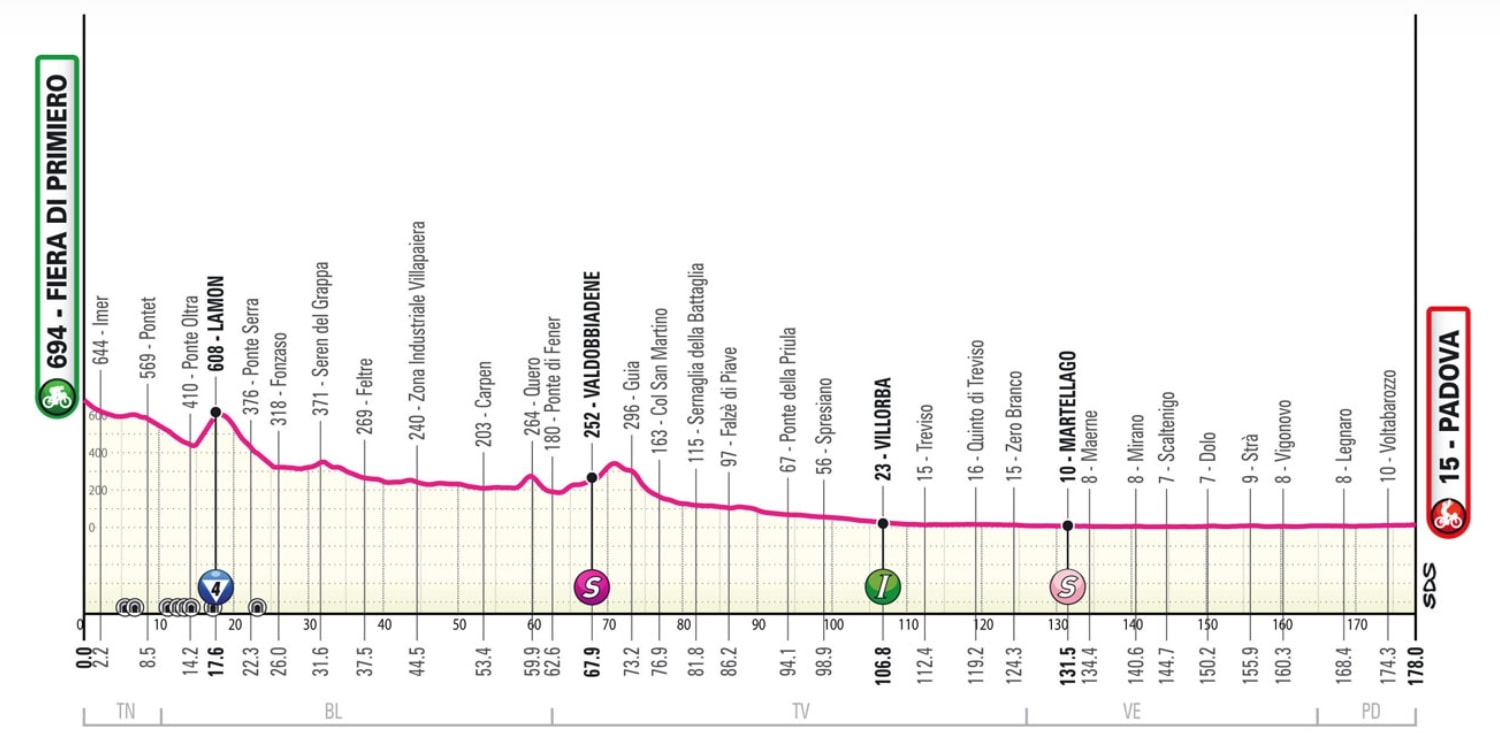
A sprint stage as the race exits the mountains via the prosecco vineyards. Arguably more importantly it’s an active rest day for the GC contenders who can recover a bit for the upcoming days. Watch out for the corners in the finish through Padova.
Stage 19 – Friday 24 May – 2850m V+

A day for the breakaway? Surely that’s the base case on a stage with 2,700m that’s open to many types of rider but it’s also ambush territory on the off-chance a rider has a slender lead and a rival with a strong team wants to hammer things.
Stage 20 – Saturday 25 May – 4250m V+

Two ascents of Monte Grappa, 18km at an average of 8.1% is tough but that’s with two brief downhills on the way so it’s more often 9% and more, especially on the upper slopes. The descents matter as much as the climbs, tricky in places.
Stage 21 – Sunday 26 May – 300m V+

A copycat stage of last year’s finish with a start in the Eur district and then the Rome criterium finish.
The Jerseys

There are four jerseys in the race: pink, cyclamen, blue and white.
Pink: the most famous one, the maglia rosa, it is awarded to the rider with the shortest overall time for all the stages added together. As such, they have covered the course faster than anyone else. It is pink because the race has been organised by La Gazzetta Dello Sport, a newspaper printed on bright pink paper. It is sponsored by Enel, an energy company.
There are time bonuses available on all the stages except the time trials:
- 10-6-4 seconds for the first three riders respectively on each stage
- 3-2-1 seconds at second intermediate sprint of the day
- 3-2-1 seconds at “Intergiro” point, look for the “I” in a green circle on the stage profiles
Cyclamen: the points competition. Riders score points at both of the intermediate sprints per day and at the finish line. The allocation of points depends on the stage in question, they are categorised with the typical sprint stages offering more points in a bid to place the purple-toned jersey on the shoulders of a sprinter who can handle arithmetic. The maglia ciclamino is sponsored by Be It, a Made in Italy marketing campaign.
-
- Category A+B stages (Stages 3,4,5,9,11,13,18,21) offer points for the first 15 riders at the finish: 50-35-25-18-14-12-10-8-7-6-5-4-3-2-1
- Category C stages: (Stages 1,6,12) offer points for the first 10: 25-18-12-8-6-5-4-3-2-1
- Category D+E: (Stages 2,7,8,10,14,15,16,17,19,20) offer points for the first 10: 15-12-9-7-6-5-4-3-2-1
- For the first intermediate sprint of each stage there are points for the first eight: 12-8-6-5-4-3-2-1
- At the Intergiro sprint also 12-8-6-5-4-3-2-1
If the intermediate sprints are confusing then read it this way:
- sprint 1: ciclamino points
- sprint 2: ciclamino points and 3-2-1 time bonuses
- sprint 3: 3-2-1 time bonuses
Blue: the mountains jersey. It is sponsored by Banca Mediolanum, a bank. There are five categories of climb:
- 13 fourth category climbs: the first three riders crossing the top of the climb win 3-2 and 1 points respectively
- 10 third category climbs: the first four riders over the top get 9-4-2-1 points
- 9 second category climbs: first six riders get 18-8-6-4-2-1 points but if it is also the finish of the stage then 26, 12, 8, 4, 2, 1 points instead
- 11 first category climbs: the first eight riders get 40-18-12-9-6-4-2-1 points but if it is also the stage finish then 50,24,16,9,6,4,2,1
- CC or Cima Coppi: a special award, the “Coppi Summit” for the highest point of the race. This year it is the Stelvio on Stage 16. The first nine win 50-30-20-14-10-6-4-2-1 points
White: for the best young rider, this is awarded on the same basis as the pink jersey, except the rider must be born after 1 January 1999, ie aged 25 or under. It is sponsored by Eataly, a restaurant and food retail company.
Now a rider can’t wear two jerseys at once, they’d get too hot and the sponsors wouldn’t get the exposure they’ve paid for. So if a rider leads several classifications, they take the most prestigious jersey for themselves and the number-two ranked rider in the other competition gets to wear the other jersey. For example if a rider has both the pink jersey and the blue mountains jersey they’ll wear pink whilst whoever is second in the mountains jersey will sport blue jersey. The hierarchy is pink > points > mountains > white.
There are also other prizes and in-race competitions such as the intermediate sprint competition which is separate to the points competition or the time bonuses also available at these spots; the breakaway prize for the rider with the most kilometres in the breakaway; the fighting spirit prize which is a combined competition for scoring across the points, mountains and so on; the team prize; and the fair play prize for teams that avoid fines and penalties.
Time cuts
All riders have to make the time cut each day to stay in the race and this is a function of the stage type and average speed:
- Stages 3,13,18,21: the winner’s time plus 7% if the average speed is less than or equal to 40 km/h; 8% of the average speed is between 40 and 45 km/h; 10% if the average speed is over 45 km/h
- Stages 4,5,9,11: the winner’s time plus 9% if the average speed is less than or equal to 37 km/h; 10% of the average speed is between 37 and 41 km/h; 11% if the average speed is over 41 km/h
- Stages 1,6,12: the winner’s time plus 11% if the average speed is less than or equal to 35 km/h; 12% if the average speed is between 35 km and 39 km/h; 13% if the average speed is over 39 km/h
- Stages 2,8,10,17,19: the winners’ time plus 19% if the average speed is less than or equal to 30 km/h; 21% if the average speed between 30 km/h and 34 km/h; 22% if the average speed is over 34km/h;
- Stages 15,16,20: the winners’ time plus 16% if the average speed is less than or equal to 30 km/h; 17% if the average speed between 30 km/h and 34 km/h; 18% if the average speed is over 34km/h;
- For TT Stages, the winner’s time plus 30%
Three Kilometre Rule
Anyone with a mechanical or crash within the final three kilometres can get the same finishing time as the group the were with at the time of the incident on Stages 1,3,4,5,6,9,11,12,13,18,20 and 21.
Bunch sprint time gaps
The protocol for time gaps in bunch sprints applies for Stages 3,4,5,9,11,13,18 and 21.
The unmissable stages
Anything can happen during the Giro but there are some stages that matter more than others, some suggestions for the must-watch days:
- Stage 2: the Oropa summit finish
- Stage 10: a short stage that suits the breakaway so look for non-stop action
- Stage 12: the “walls” of the Marche region
- Stage 15: the hardest stage with the finish above Livigno
- Stage 17: a hard day in the Dolomites
- Stage 20: Monte Grappa and the final mountain stage
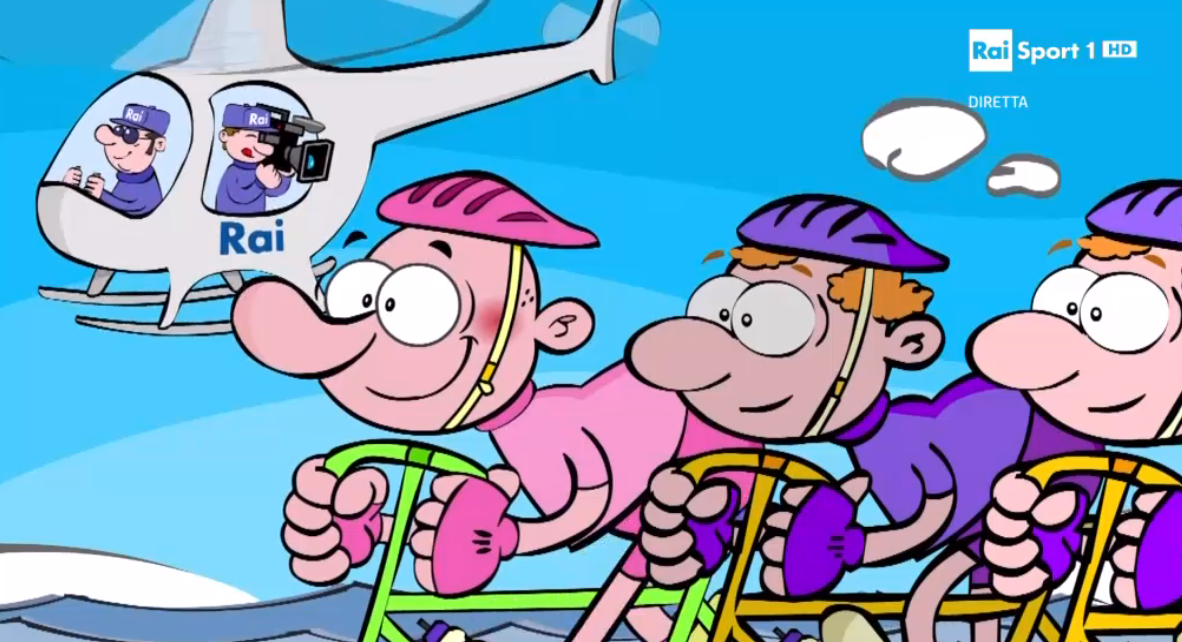
TV
All stages will be broadcast live from start to finish. Host broadcaster RAI offers the richest coverage with experienced commentators as well as two roving reporters on motorbikes to add extra info.
If you want English coverage, there’s Eurosport, in the US it’s on Max, Flobikes for Canada, Australia SBS and in Japan on J-Sports.
The timing varies but as a rule the finish is expected for around 5.15pm CEST each day.

Hadn’t noticed that you probably (I guess) mixed up a different road up to Bocca della Selva (the 2021 one?) as the uphill finish of st. 10.
This way up, it’s still mostly a big ring climb, but the last *4 kms* aren’t at all, slightly over 8% more often than not, albeit it eases at some 7% just before the flamme rouge, but from then on it’s steady 8% peaking at 10%.
Nothing wild, but more than enough to force some selection (especially with some solid teamwork on the lower slopes), whether with a good go at -3 km or more probably in the last km itself.
You’re right, the stop is a bit steeper than “pedalabile”.
This is high level knowledge, thank you for the extra detail and being willing to share for free.